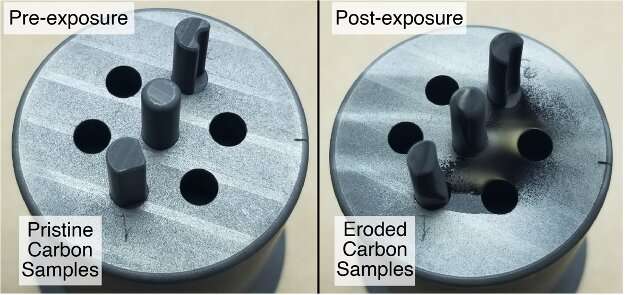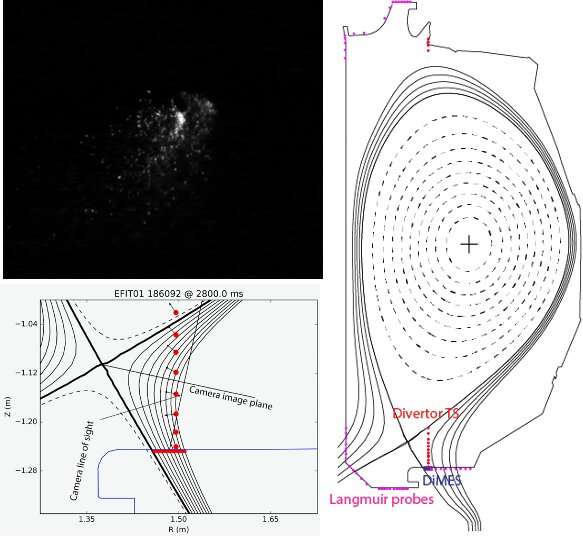Feeling the heat: Fusion reactors used to test spacecraft heat shields

Spacecraft have long used heat shields for protection during entry into planetary atmospheres. Future missions to the outer solar system will need more sophisticated materials than currently exist. The extreme heating conditions needed to study new shield materials are, however, very difficult to achieve experimentally on Earth. Scientists working at the DIII-D National Fusion Facility at General Atomics (GA) recently developed an innovative approach that uses the conditions inside a fusion reactor for testing heat shield materials.
During high-speed atmospheric entries of up to 100,000 miles per hour, such as those required in missions to the Solar System's gas giants, the atmospheric gas surrounding the spacecraft turns into plasma (a mixture of ions and electrons) and spacecraft temperatures increase to more than 10,000 F. To protect the scientific payload, the heat shield material burns (or ablates) in a controlled manner, which pulls the excess heat away from the core of the spacecraft.
Past heat shield testing approaches using lasers, plasma jets, and hypervelocity projectiles suffered from the problem that no single method could simulate the exact heating conditions present during a high-speed atmospheric entry. Consequently, past models of heat shield behavior have sometimes over- or under-predicted ablation of the heat shield, with potentially disastrous results. The experiments at DIII-D demonstrated that the hot plasma created by a fusion reactor during operation offers a novel and potentially improved way of modeling heat shield behavior, especially for entries into Venus or the gas giants (Figure 1).
"Certain regions of the plasma in DIII-D closely approximate the conditions created when heat shields impact planetary atmospheres at extreme velocities," said Dr. Dmitri Orlov of the University of California San Diego, who led the multi-institutional team. "Our intent with these experiments was to leverage both these conditions and DIII-D's rich suite of diagnostic instruments to develop a more accurate model of heat shield behavior."
Most experiments conducted at DIII-D are intended to explore the physics basis for fusion energy. An existing system at DIII-D, known as the Divertor Materials Evaluation System (DiMES), is designed to test materials for future reactors. DiMES can expose test samples to various plasma conditions as well as launch pellets of test material through the plasma. Dr. Orlov and Dr. Eva Kostadinova of Auburn University, working with a team of scientists, undergraduate, and graduate students, used DiMES to study the ablation rates of carbon samples under extreme conditions and refine predictive models for carbon-based heat shield behavior (Figure 2). These experiments were conducted under the auspices of the Frontier Sciences program, funded by the U.S. Department of Energy, to provide access to DIII-D and other DOE-funded facilities to the broader physics community.
"DIII-D features relatively long plasma discharges with well-controlled stable conditions at the edge, where the heat flux and the flow speed are similar to those experienced during atmospheric entries," said Dr. Kostadinova. "This allowed us to simulate some of the most extreme conditions heat shields have experienced, such as the entry of the Galileo probe to Jupiter's atmosphere, without the need to launch our test samples at high velocities."

Because DIII-D is one of the most flexible and highly instrumented fusion reactors in the world, the team was able to gather a range of valuable data on the behavior of the samples. By using scaling techniques, they extrapolated the results to larger projectiles and longer exposures, which allowed for comparison with experimental data from previous space flight missions and other on-ground testing facilities. The results offer considerable promise to develop the advanced heat shield materials necessary for planned missions to Venus and the Jovian moons.
More information: Abstracts:
WI02.00002. The Hypervelocity impact in stellar media: Spacecraft Heat Shield study in DIII-D
TO06.00007. Laboratory study of carbon ablation in Jupiter-like heating environment
PO08.00012. Modeling carbon pellet injection in DIII-D divertor for advanced material studies
CP11.00038. Observing Dust Response In An Inductive Plasma Generator
Provided by American Physical Society




















